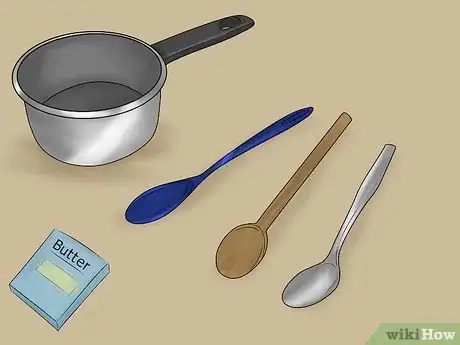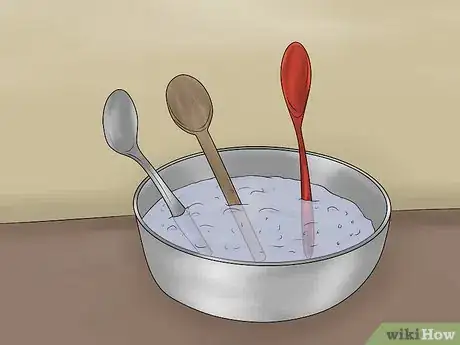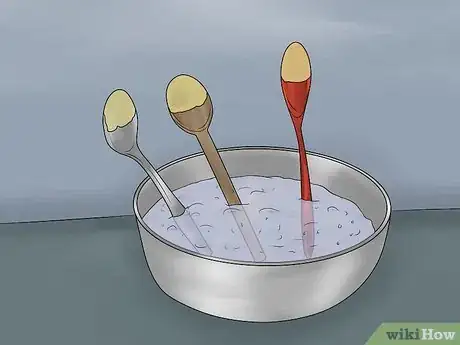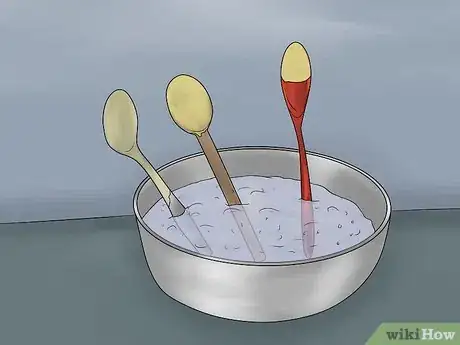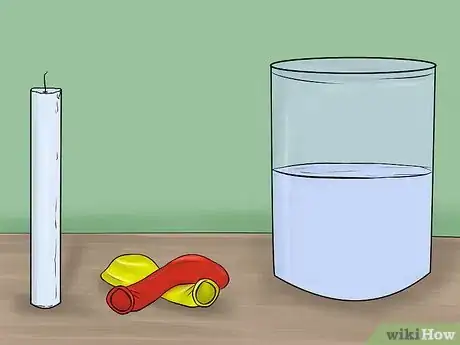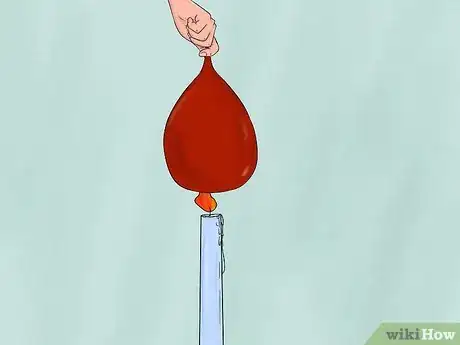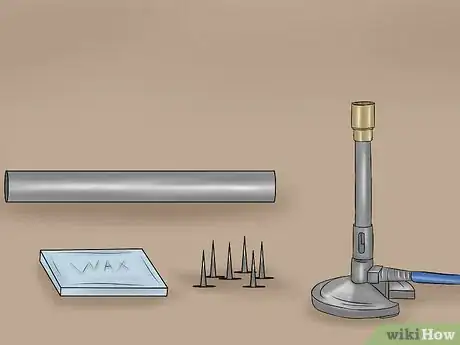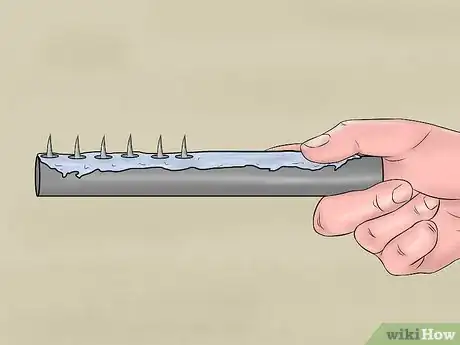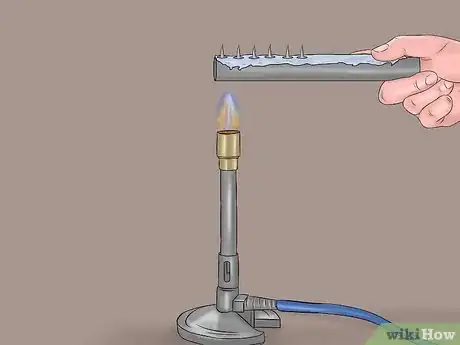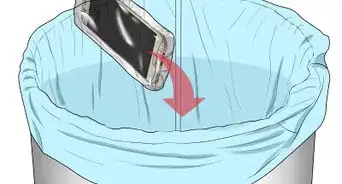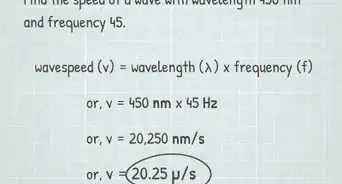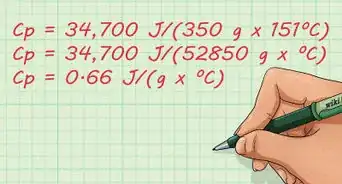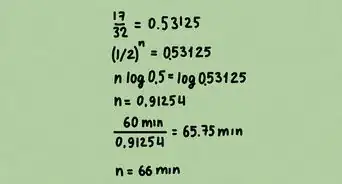This article was co-authored by Bess Ruff, MA. Bess Ruff is a Geography PhD student at Florida State University. She received her MA in Environmental Science and Management from the University of California, Santa Barbara in 2016. She has conducted survey work for marine spatial planning projects in the Caribbean and provided research support as a graduate fellow for the Sustainable Fisheries Group.
This article has been viewed 161,895 times.
Whether you realize it or not, heat conduction is an important part of our lives. You probably use it every single day when you’re cooking a meal or using a radiator. The transfer of heat from a heat source to an object is basic heat conduction. If you’re looking for a way to test it yourself or explain it to a child there are a few simple experiments you can choose from.
Steps
Performing a Heat Conduction Experiment With Hot Water
-
1Gather your materials. You’ll need a cooking pot, a stick of butter, and three types of spoons. The spoons you need are a wooden stirring spoon, a plastic cooking spoon, and a regular metal spoon.[1]
- You need to get spoons that are relatively long. If you put the spoon in the pot the handle should be coming out of the pot by about three or four inches.
- If you want a precise measurement for heat conduction you can also use thermometers. In that case, you’ll need three thermometers and electrical tape.
-
2Boil a pot of water. Fill a cooking pot of any size about halfway full with water and place it on a normal stove burner. Boil water the same way you would if you were going to make spaghetti or pasta.
- While any pot will work, a shallow, broad pot might help you balance the butter on the spoons more easily.
Advertisement -
3Place the spoons in the water. Take each of your three types of spoons and lay them in the water handle down. The bowl portion of the spoon should be comfortably out of the water. You can place the spoons next to each other or facing away from each other. The bowl portion of the spoon will be at a diagonal. Try to make that diagonal as close to horizontal as possible by leaning the end of the handle that is in the water up against the side of the pot.[2]
- If you are using thermometers to measure the heat conduction, tape the thermometers to the handles of each spoon before you put them in the water.
-
4Place butter on the spoons. Cut three slices of butter. You should cut them about a quarter inch each, but it isn’t that important. Now place one slice in each of the spoons. Make sure they don’t slide into the water. Be careful not to touch the metal spoon as you place the butter on it.[3]
-
5Wait a few minutes and check the butter. After about two minutes, come back and check the butter. You’ll notice that the butter on the metal spoon has melted significantly, the butter on the wooden spoon has melted a little bit, and the butter on the plastic spoon has barely melted at all.This is heat conduction at work.[4]
- Metal conducts heat better than wood, which conducts heat better than plastic.
- If you are using thermometers, check your thermometer readings after a few minutes. The same results will appear with specific numbers.
Performing a Heat Conduction Experiment With a Balloon
-
1Gather your materials. For this experiment, you’ll need regular latex balloons, a candle, and some water.[5] They are some pretty simple materials. Don’t get blown up balloons. Wait until you are doing the experience to put air inside them.
-
2Hold a balloon over the candle flame. Light your candle with a match or lighter and then blow up one of your balloons. Blow it up to a decent size, not too small or large. The size doesn’t particularly matter for this experiment. Hold the balloon an inch or two above the candle.[6] Be sure to keep your fingers out of the way. Within ten seconds the balloon will pop.
- The balloon pops because the candle heated up the balloon, which weakened the balloon.
-
3Fill a balloon with water. Take your second balloon and fill it halfway full with room temperature water. Hold the balloon over the candle flame again. This time you’ll notice that the balloon does not pop. You can even let the candle flame touch the balloon and it won’t pop.[7]
- The candle is warming the water rather than popping the balloon. That’s why water isn’t going flying everywhere. The balloon conducts heat and is able to transfer it to the water without damaging the balloon.
- If you hold the candle to the balloon long enough it will pop, but it will take much longer than a balloon filled without air.
Performing a Heat Conduction Experiment With a Bunsen Burner
-
1Gather your materials. For this experiment, you’ll need a Bunsen burner, a six-inch metal rod, 10 g of wax, and 4 metal tacks. If you cannot secure the metal rod to the Bunsen burner, you will also need heat resistant gloves.
- You can buy wax and metal tacks at a craft store.
-
2Use the wax to secure the tacks. Mold the wax around the flat end of the tacks so that they will stick to the metal rod. [8] Put one tack every inch along the length of the metal rod. Make sure that they are all on the same side of the rod.
- You should have six tacks connected to the metal rod in all.
-
3Turn your Bunsen burner on and secure the rod. Light a match or a lighter and then turn the gas tap on the Bunsen burner slightly to the left to allow gas to release from the spigot. You will hear a slight hissing when the gas is on. Place the flame over the gas spigot and the Bunsen burner will light. Be careful. Once you’ve lit the Bunsen burner you can secure the metal rod over it. [9] The whole rod doesn’t need to be over the burner, just the outermost inch or so.
- If you have heat resistant gloves and no other way to secure the metal rod over the burner, you can hold the rod there. Keep a steady hand.
-
4Watch as the tacks fall off. As the metal rod conducts heat the tacks closest to the burner will start to fall off. [10] The wax will melt and the tacks will drop off onto the table. Once the final tack falls off you can turn off the Bunsen burner. Be careful not to touch the rod with your bare hands.
- This experiment illustrates how metal conducts heat. You can visualize how one end of the metal rod got hot rather than the entire rod heating up at an equal pace. This is based on where the Bunsen burner was placed. If you placed the burner in the middle of the rod, the heat would start in the middle and extend outwards in either direction. [11]
Community Q&A
-
QuestionWhich conducts heat better, aluminum or copper?
 Community AnswerCopper has a higher thermal conductivity, and therefore is superior to aluminum in processor cooling. Copper is better at conducting heat than aluminum, but aluminum is able to radiate the heat into the air better than copper because of its lower density.
Community AnswerCopper has a higher thermal conductivity, and therefore is superior to aluminum in processor cooling. Copper is better at conducting heat than aluminum, but aluminum is able to radiate the heat into the air better than copper because of its lower density. -
QuestionWhat does this experiment show about the conduction of heat?
 Community AnswerIt shows that even though the flame is in one place, the heat can travel through the metallic bonds/sea of electrons.
Community AnswerIt shows that even though the flame is in one place, the heat can travel through the metallic bonds/sea of electrons. -
QuestionHow does the temperature of the water effect the experiment?
 Community AnswerBecause it is showing heat transfer, it won't have accurate results if you don't have the right temp.
Community AnswerBecause it is showing heat transfer, it won't have accurate results if you don't have the right temp.
References
- ↑ https://www.stemlittleexplorers.com/en/heat-conduction-experiment/
- ↑ https://coolscienceexperimentshq.com/conducting-heat/
- ↑ https://www.stemlittleexplorers.com/en/heat-conduction-experiment/
- ↑ https://www.stemlittleexplorers.com/en/heat-conduction-experiment/
- ↑ https://www.abc.net.au/science/surfingscientist/pdf/teachdemos_7.pdf
- ↑ https://www.scienceworld.ca/resource/fireproof-balloons/
- ↑ https://www.scienceworld.ca/resource/fireproof-balloons/
- ↑ http://demonstrations.wolfram.com/ExperimentOnHeatConduction/
- ↑ http://demonstrations.wolfram.com/ExperimentOnHeatConduction/
About This Article
Heat conduction occurs when heat transfers from a source to an object. You can perform an experiment that shows heat conduction using a pot of water and spoons. Start by bringing a large pot of water to a boil and then removing it from the heat. Then, place 1 wooden spoon, 1 plastic spoon, and 1 metal spoon in the water so the bowl on each spoon is sticking up out of the water and resting on the side of the pot. Place a slice of butter into each of the spoon bowls and wait a few minutes. When you check the spoons, you'll notice that the butter is more melted in the metal spoon than it is in the wooden and plastic spoons. This is because metal conducts heat better than wood and plastic. You'll also notice that the butter is more melted in the wooden spoon than in the plastic spoon, since wood conducts heat better than plastic. To learn how to do a heat conduction experiment with a balloon, keep reading!
